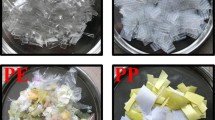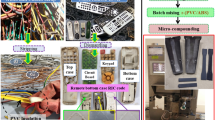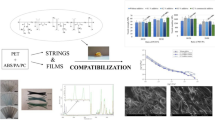Abstract
In this study, chemical recycling products of waste poly(ethylene terephthalate) with oligoesters were used as new plasticizers for poly(vinyl chloride) (PVC). The preparation conditions of the dry blend mixtures of the suspension PVC containing synthesised plasticizers were similar to the conditions of the preparing mixtures with commercial plasticizers. The plasticization efficiency of PVC plasticizers was then examined by analysis of the mechanical, physical and chemical properties, as well as the thermal resistance and migration of plasticizer molecules from polymer matrix. Test results proved that compositions with synthesised oligomeric plasticizers possessed similar or better properties than those containing commercial oligomeric plasticizers and much better properties than those having monomeric plasticizers. Thermal stabilities of the proposed plasticizers were higher than those of the commercial plasticizers either monomeric (bis(2-ethylhexyl)phthalate) or oligomeric, despite the fact that the synthesised oligoesters did not contain any antioxidant. The best properties, especially low volatility, very good mechanical properties, low migration were resulted of the transesterification of the waste PET with oligoesters based on adipic acid, triethylene glycol and 2-ethylhexanol which were selected as plasticizers synthesised on the technical scale. The tested plasticized PVC compositions possessed very good tear resistance, tensile strength, decrease of weight loss after 168 h at 80 °C and low migration. Processing properties of PVC compositions containing these synthesised plasticizers confirmed their effectiveness in these compositions for extrusion process.




Similar content being viewed by others
References
Selvaraj KK, Sundaramoorthy G, Ravichandran PK, Girijan GK, Sampath S, Ramaswamy BR (2015) Phthalate esters in water and sediments of the Kaveri River, India: environmental levels and ecotoxicological evaluations. Environ Geochem Hlth 37:83–96
Wypych G (2004) Handbook of plasticizers. Chem Tech Publishing, Toronto-New York
Rahman M, Brazel CS (2004) The plasticizer market: an assessment of traditional plasticizers and research trends to meet new challenges. Prog Polym Sci 29:1223–1248
Kastner J, Cooper DG, Marić M, Dodd P, Yargeau V (2012) Aqueous leaching of di-2-ethylhexyl phthalate and “green” plasticizers from poly (vinyl chloride). Sci Total Environ 432:357–364
Sunny MC, Ramesh P, George KE (2004) Use of polymeric plasticizers in polyvinyl chloride to reduce conventional plasticizer migration for critical applications. J Elastom Plast 36:19–31
Pielichowski K, Świerz-Motysia B (2006) Influence of polyesterurethane plasticizer on the kinetics of poly(vinyl chloride) decomposition process. J Therm Anal Calorim 83:207–212
Fenollar O, Sánchez-Nacher L, García-Sanoguera D, López J, Balart R (2009) The effect of the curing time and temperature on final properties of flexible PVC with an epoxidized fatty acid ester as natural-based plasticizer. J Mater Sci 44:3702–3711
Marcilla A, García S, García-Quesada JC (2004) Study of the migration of PVC plasticizers. J Anal Appl Pyrol 71:457–463
Yin B, Hakkarainen M (2011) Oligomeric isosorbide esters as alternative renewable resource plasticizers for PVC. J Appl Polym Sci 119:2400–2407
Zhou J, Ritter H (2011) Copolyesters as non-toxic plasticizers. Polym Int 60:1158–1161
Nihul PG, Mhaske ST, Shertukde VV (2014) Epoxidized rice bran oil (ERBO) as a plasticizer for poly(vinyl chloride) (PVC). Iran Polym J 23:599–608
Lakeev SN, Maydanova IO, Mullakhmetov RF, Davydova OV (2016) Ester plasticizers for polyvinyl chloride. Russ J Appl Chem 89:1–15
Jia PY, Feng GD, Hu Y, Zhou YH (2016) Synthesis and evaluation of a novel N-P-containing oil-based fire-retardant plasticizer for poly(vinyl chloride). Turk J Chem 40:65–75
Calò E, Greco A, Maffezzoli A (2011) Effects of diffusion of a naturally-derived plasticizer from soft PVC. Polym Degrad Stabil 96:784–789
Langer E, Waśkiewicz S, Lenartowicz-Klik M, Bortel K (2015) Application of waste poly(ethylene terephthalate) in the synthesis of new oligomeric plasticizers. Polym Degrad Stabil 119:105–112
Mekonnen T, Mussone P, Khalil H, Bressler D (2013) Progress in bio-based plastics and plasticizing modifications. J Mater Chem A 1:13379–13398
Waśkiewicz S, Zenkner K, Langer E, Lenartowicz M, Gajlewicz I (2013) Organic coatings based on new Schiff base epoxy resins. Prog Org Coat 76:1040–1045
Wilkes C, Summers J, Daniels C (2005) PVC Handbook. Carl Hanser Verlag, Munich
Author information
Authors and Affiliations
Corresponding author
Rights and permissions
About this article
Cite this article
Langer, E., Waśkiewicz, S., Bortel, K. et al. Application of new oligomeric plasticizers based on waste poly(ethylene terephthalate) for poly(vinyl chloride) compositions. Iran Polym J 26, 115–123 (2017). https://doi.org/10.1007/s13726-016-0502-0
Received:
Accepted:
Published:
Issue Date:
DOI: https://doi.org/10.1007/s13726-016-0502-0




